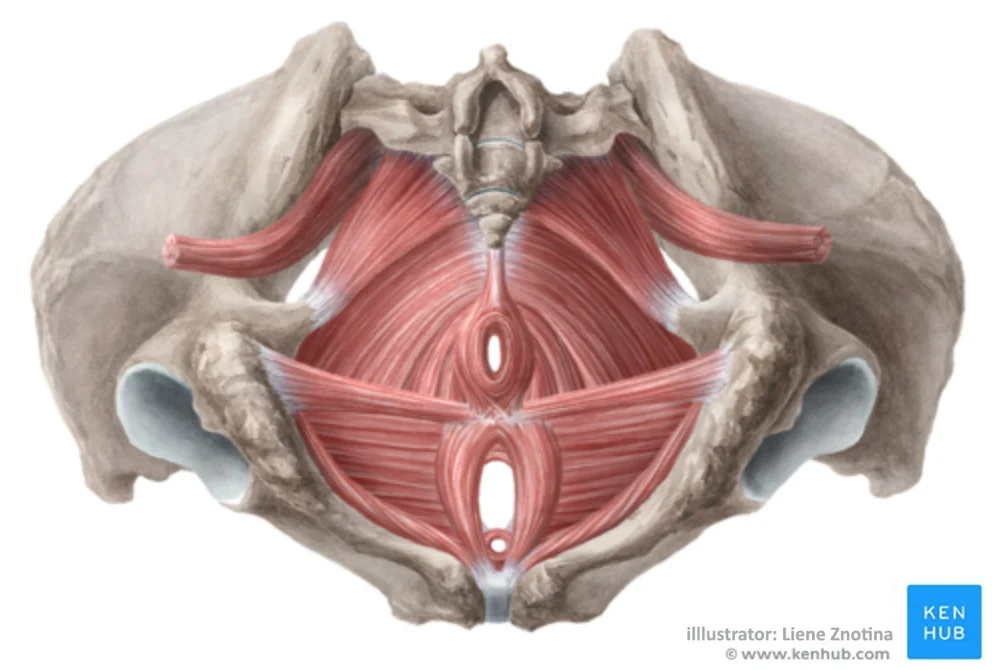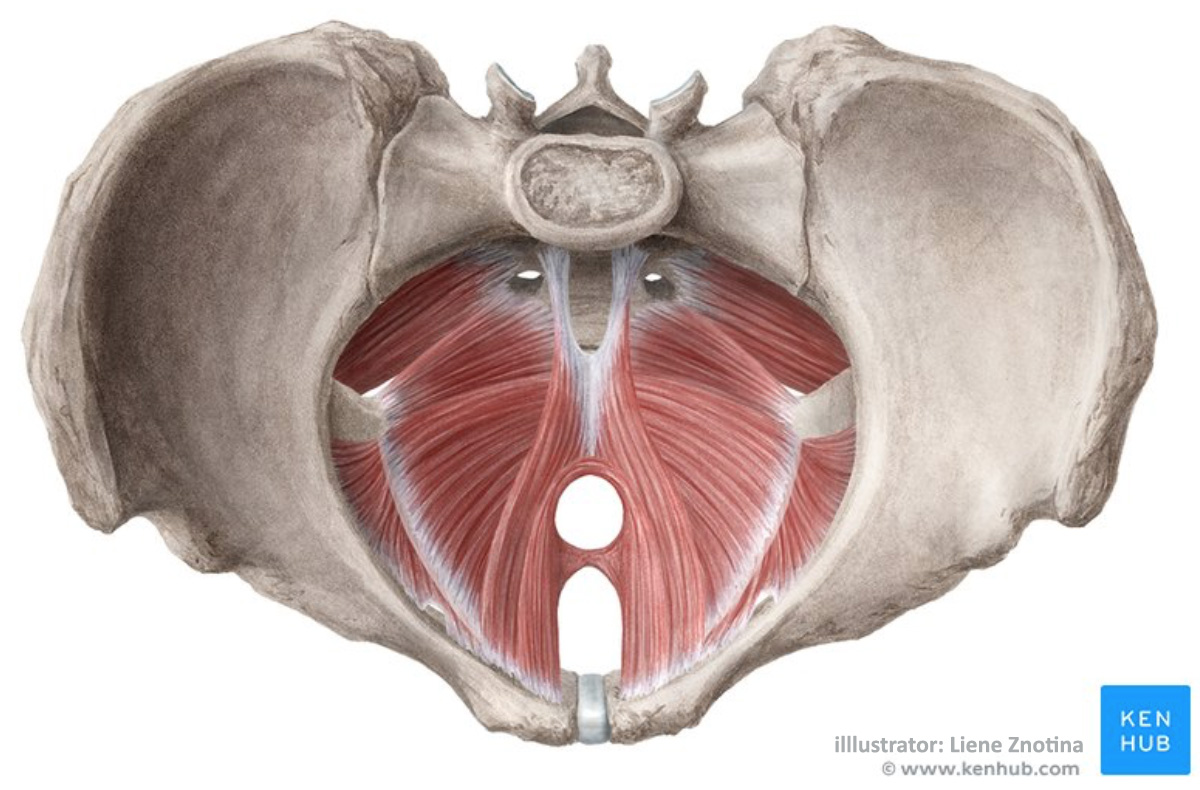The Pelvic floor is often taboo, forgotten or undervalued! We usually learn about our pelvic floor when we have a problem. Well today, I would like to present how the pelvic floor muscles normally function.
The more you know about them and the more likely you’ll be able to protect this very important and complicated part of the body. We’ll also go through a few interesting common myths…
A little bit of anatomy
I don’t want to bother you with tons of complex anatomy descriptions, so let’s make this part short and concise.
Pelvic floor muscles’ location
The pelvic "floor" is an appropriate name because it’s situated at the bottom of the pelvis, and closes off the opening that would otherwise allow the pelvic and abdominal contents above it to fall through!
Pelvic floor muscles’ attachments
Female Pelvic Floor Muscles - Bottom view - Used with permission from © Kenhub (https://www.kenhub.com); Illustrator: Liene Znotina
The pelvic floor muscles are a group of muscles at the base of the pelvis. The pelvic floor muscles have attachments to your pubic bone, tailbone and pelvis. Basically, they stretch from the pubic bone to the tailbone (front to back) and attached inside the 2 sitz bones too, on the ischial spines (side to side).
The pelvic floor muscles are often described as a sling, hammock, parachute or trampoline and have the ability to move up and down.
Even if you can’t see them, you can consciously control and exercise them, similar to our legs, arms or abdominal muscles.
Female Pelvic Floor Muscles - Deep layer - Top view - Used with permission from © Kenhub (https://www.kenhub.com); Illustrator: Liene Znotina
There are different layers to the pelvic floor:
- There’s a superficial layer : able to squeezing the entrance of the vagina and rectum
- and a deep layer : supporting your pelvic organs (bladder, uterus, bowel).
The deepest and most extensive layer of the pelvic floor muscles is found in what is called the pelvic diaphragm muscles.
If you still have a hard time picturing what your pelvic floor muscles look like, here’s a helpful video from the Continence Foundation of Australia. I don’t totally agree with the way they explain how to exercise your pelvic floor, but I’ll get to that below… For now, focus on the 3D animation illustrating the muscles of the pelvic bowl – it’s stunning!
Pelvic Floor Muscles and Diaphragm – Working as a Team
The pelvic floor muscles don’t work in isolation.
It’s important to note that the pelvic floor and diaphragm move together. There’s a back-and-forth communication between them.
Unlike the previous video, simply recommending squeezing your pelvic floor muscles, I advocate exercising your pelvic floor muscles in synergy with breathing phases.
Imagine them moving like 2 synchronized jellyfish:
on the inhale: the diaphragm and the pelvic floor muscles drift down,
on the exhale: the diaphragm and the pelvic floor muscles rise up.
They depend on each other for proper function. They also need to be properly aligned, and this is where alignment plays a key role in healthy pelvic floor muscle function.
The pelvic floor muscles – an extraordinary multitasker!
What is the function of the pelvic floor?
The functions of the pelvic floor are numerous. Among them, we find 5 main jobs:
· 1. Support the pelvic organs (bladder, uterus and bowel)
The urinary system, intestines, and reproductive organs are all supported by ligaments and pelvic floor muscles. Without the support of the pelvic floor, the uterus, bladder, and bowel would lack stability within the pelvis. Additionally, during pregnancy, the pelvic floor muscles provide essential support for the baby and assist in childbirth.
· 2. Maintain and control continence (both urinary and rectal)
The pelvic floor muscles wrap around the body’s exit canals. They squeeze tightly closed to keep urine and stool inside the body but they can also relax to let content out when time is right.
· 3. Allow sexual function and sexual satisfaction
The pelvic floor muscles are active during sex and orgasm, helping to provide tone, increase sensation, and enhance sexual satisfaction.
For men, these muscles play a key role in erectile function and ejaculation.
In women, contracting the pelvic floor muscles can enhance sexual sensation. Note that sufficient strength in the pelvic floor muscles is important for achieving orgasm!
· 4. Provide stability to the spine / pelvic area
Because of their attachments to the pelvis and hips, the pelvic floor muscles are an important part of your “core”. Abs, deep back muscles, pelvic floor muscles, and diaphragm work together to provide stability to the spine and pelvic area.
Imagine your abdomen being a canister:
the pelvic floor is the floor
the diaphragm is the roof
the abs and back are the sides
The pelvic floor muscles should be able to fire quickly and relax quickly to handle the stress of your daily life and activities. They stabilize your every move (jumping, sneezing, coughing, laughing…)!
· 5. Sump-pump
Just like the soles of your feet act to pump blood and lymphatic fluid back up towards your heart, the pelvic floor muscles act as a pump for the pelvis.
5 top myths about pelvic floor muscles
Let’s spread the word and break taboos about pelvic floor!
I work with a lot of women from pre to post-pregnancy. So let me share the 5 top myths I often encounter about the pelvic floor.
· Myth 1: Only women have a pelvic floor
Fact: False
A man’s pelvic floor is different than a woman’s, but anyone with a pelvis has a pelvic floor! For men, pelvic floor problems are less common because the male version isn’t pierced by the vagina, and doesn't undergo the stress of pregnancy and/or childbirth.
· Myth 2: Urinary incontinence is normal after having babies, and as we age
Fact: It is common – but it’s NOT Normal!
Pelvic floor dysfunctions are not inevitable, and it’s never too late to make improvements. The same goes for postpartum back pain!
· Myth 3: Having a C-section will prevent all dysfunction of the pelvic floor muscles post-pregnancy
Fact: Nope...
Even if you didn’t push your baby out, your pelvic floor muscles have been stretched and strained by the 9 months of pregnancy and the baby’s weight, putting stress inside your belly. Postnatal exercises are key to recovering, restoring, strengthening, and improving your pelvic floor muscles and whole body afterward, regardless of the way you gave birth.
· Myth 4: All pelvic floor dysfunctions are related to muscle weaknesses
Fact: There are typically two kinds of pelvic floor issues that can cause dysfunction.
If you have hypotonic pelvic floor muscles - or low muscle tone - you may experience issues related to incontinence and pelvic organ prolapse.
If you’re a woman with hypertonic pelvic floor muscles - or muscles that are too tight - You may experience urgency, frequency, and constipation. You may also experience pain with intercourse.
Remember that, as with any other functional muscles in your body, your pelvic floor needs to be able to both contract and relax efficiently.
· Myth 5: Kegel exercises will solve all your pelvic floor issues
Fact: False
Kegel exercises primarily target the superficial layers of the pelvic floor and don’t engage the deeper layers. Additionally, as mentioned above, not all pelvic floor dysfunctions are due to weak muscles; in fact, Kegels may worsen symptoms for individuals with overly tight pelvic floor muscles!
Time to give your pelvic floor muscles the attention they deserve
Let’s acknowledge their fundamental role in living an active, pain-free life to the fullest!
Now, let’s talk about pelvic floor exercises. We’ll see how core breathing exercises can help improve the function of pelvic floor muscles!
A special thank you to Kenhub.com and their illustrators for letting me use their stunning images.





